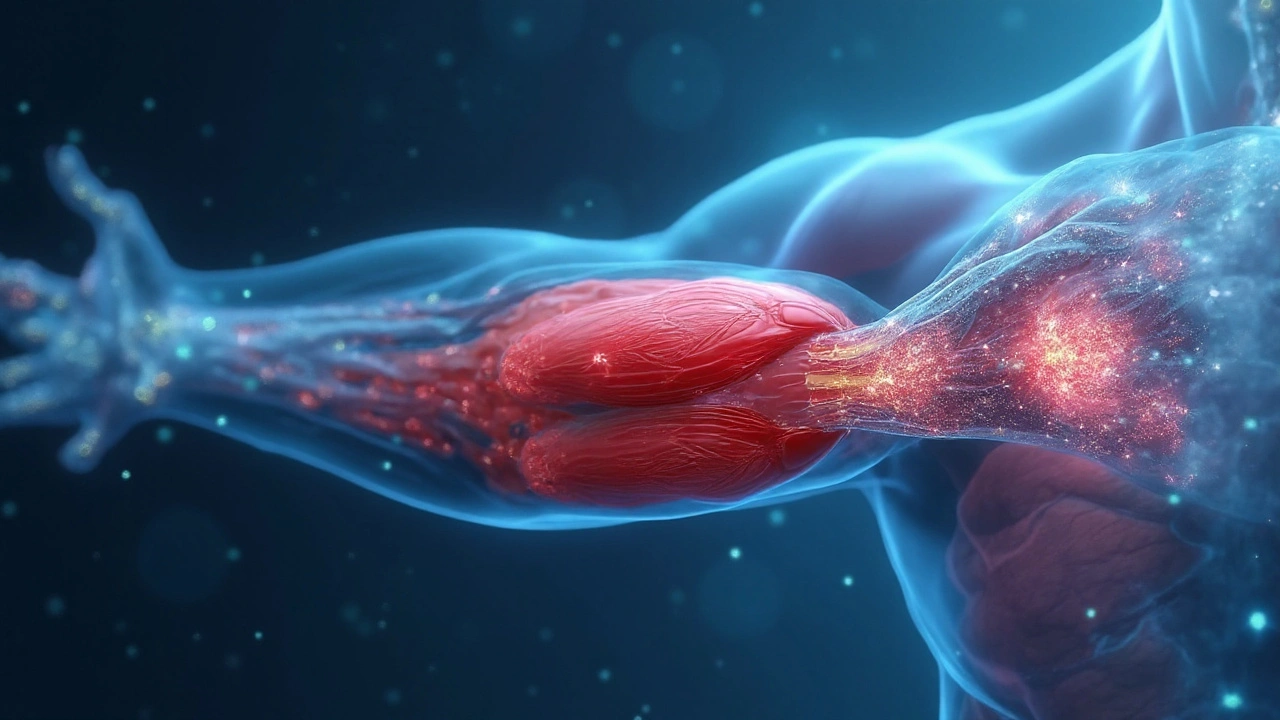
Calcium is a mineral that regulates muscle contraction, nerve signaling and bone health. Our bodies store about 1,000g of calcium, most of it in bones, while a tiny fraction circulates as calcium ions (Ca²⁺) that power every twitch. When calcium balance tips, muscles can feel tight, achy or crampy. This article breaks down why calcium matters, how it interacts with other electrolytes, and what you can do today to keep stiffness at bay.
Why Muscle Stiffness Happens
Every time you move, muscle fibers fire and then relax. The firing step needs an electrical spark that travels along the neuromuscular junction - the connection between a nerve ending and a muscle cell. The spark opens voltage‑gated calcium channels, flooding the muscle cell with Ca²⁺. These ions latch onto proteins called troponin, which slide the actin and myosin filaments past each other - that’s the contraction.
Relaxation requires calcium to be pumped back into the sarcoplasmic reticulum - an internal storage tubule by an ATP‑powered pump (SERCA). If calcium stays in the cytoplasm too long, the muscle can’t fully relax, leading to a feeling of tightness or a full‑blown cramp.
Calcium’s Direct Role in Preventing Stiffness
Three mechanisms keep stiffness down:
- Rapid release: Adequate calcium ensures the initial contraction is strong enough to complete the movement without over‑working the muscle.
- Efficient re‑uptake: Sufficient calcium maintains the gradient that drives SERCA pumps, so calcium clears quickly.
- Signal modulation: Calcium interacts with other electrolytes - especially magnesium - to fine‑tune the signal. Magnesium competes with calcium for entry points, preventing excess calcium buildup.
When any of these steps falter, you feel a knot in the muscle. Research from the British Journal of Sports Medicine (2023) showed athletes with plasma calcium below 2.2mmol/L experienced 40% more stiffness episodes than those in the normal range.
Calcium vs. Magnesium: A Quick Comparison
| Property | Calcium | Magnesium |
|---|---|---|
| Primary function | Triggers contraction | Facilitates relaxation |
| Typical RDA (adult) | 1,000mg | 310‑420mg |
| Deficiency symptom | Muscle cramps, spasms | Twitches, irritability |
| Interaction | Works with magnesium to avoid overload | Blocks excess calcium entry |
Both minerals are essential, but they play opposite sides of the same coin. Too much calcium without enough magnesium can actually increase stiffness, because the re‑uptake pumps slow down. Balancing the two is key.
Vitamin D - The Unsung Enabler
Vitamin D is a fat‑soluble vitamin that boosts intestinal calcium absorption. Without sufficient vitamin D, even a diet rich in calcium may only deliver 10‑15% of the needed amount. Seasonal studies in the UK show that serum vitamin D levels drop below 20ng/mL during winter, coinciding with a 25% rise in reported muscle stiffness.
Ensuring 800‑1,000IU of vitamin D daily (or higher for those with low baseline levels) keeps calcium absorption efficient, which in turn supports smooth muscle cycling.

Real‑World Dietary Sources
Getting calcium from food is usually safer than high‑dose supplements. Below are the top sources and their typical calcium content per 100g:
- Cheddar cheese - 720mg
- Greek yogurt - 110mg
- Tofu (calcium‑set) - 350mg
- Collard greens - 140mg
- Almonds - 260mg
Pair these foods with a vitamin D source - like oily fish (salmon, 400IU per 100g) or fortified milk - to maximize uptake.
When to Consider Calcium Supplements
Supplements are useful if you fall into any of these groups:
- Post‑menopausal women with reduced bone density.
- Vegans who avoid dairy and have limited fortified alternatives.
- Athletes training intensively and losing electrolytes through sweat.
Choose a chelated form (calcium citrate or calcium lactate) - they dissolve better in the stomach, especially if you take them between meals. A typical dose is 500mg split into two servings, taken with vitamin D and a small amount of magnesium (e.g., 200mg). Avoid mega‑doses (>2g/day) unless prescribed, as they can cause kidney stones.
Practical Tips to Keep Stiffness at Bay
- Start the day with a calcium‑rich breakfast - think fortified cereal or yogurt.
- Stay hydrated; water helps move electrolytes through cells.
- Include a magnesium source (nuts, seeds, leafy greens) in every meal.
- Get 15‑30minutes of sunlight daily in summer, or consider a vitamin D supplement in winter.
- Stretch gently after activity; this gives the SERCA pumps a chance to clear calcium.
These habits work together to maintain the delicate calcium‑magnesium‑vitaminD triad that keeps muscles smooth.
Related Concepts and Next Steps
Understanding calcium’s role opens doors to deeper topics within the health cluster. You might explore:
- Electrolyte balance - how sodium, potassium and chloride join calcium and magnesium to regulate fluid shifts.
- RDA guidelines - how age, gender and pregnancy affect recommended intakes.
- Bone density testing - why strong bones often mean better muscle performance.
- Prolonged dehydration - its impact on calcium signaling and cramp risk.
Each of these topics builds on the core idea that minerals are not isolated; they act as a network that powers every movement.

Frequently Asked Questions
Can I get enough calcium from a plant‑based diet?
Yes, if you include fortified plant milks, calcium‑set tofu, almonds, and leafy greens. Pair them with vitamin D sources or supplements to improve absorption.
Why do I still get cramps after taking calcium pills?
Cramps often signal an imbalance, not just a lack of calcium. Check your magnesium intake, stay hydrated, and make sure you have enough vitamin D. Talk to a GP about blood tests for electrolyte levels.
How much calcium is safe to take daily?
For most adults, 1,000mg is the recommended amount. Upper safe limits sit at 2,500mg. Exceeding this repeatedly may raise the risk of kidney stones and interfere with iron absorption.
Is calcium citrate better than calcium carbonate?
Calcium citrate absorbs well on an empty stomach and is gentler on the stomach, making it a good choice for most people. Calcium carbonate needs stomach acid, so it works best with meals.
What role does vitamin D play in muscle stiffness?
Vitamin D ramps up the gut’s ability to pull calcium into the bloodstream. Low vitamin D means less calcium available for the contraction‑relaxation cycle, which can leave muscles feeling tight.

Michelle Wigdorovitz
September 21, 2025 AT 23:42Wow, this breakdown really hits the spot. I always thought calcium was just about bones, but seeing how it powers every twitch makes sense. I’ve been loading up on Greek yogurt and fortified cereal for breakfast, and I swear my legs feel looser after a quick stretch. Pairing it with a handful of almonds for that extra magnesium boost is a game‑changer. Also, getting a little sun in the morning helps my vitamin D levels stay up, so the calcium absorption doesn’t slack off. Definitely gonna keep a calcium‑rich snack handy during my evening jogs.
Arianne Gatchalian
September 21, 2025 AT 23:53Totally agree! Adding a splash of fortified milk to my morning oatmeal has cut down the post‑workout tightness I used to get. Plus, staying hydrated really helps the electrolytes move around, so the SER‑CA pumps don’t get stuck.
Aly Neumeister
September 22, 2025 AT 01:00Honestly, I’m skeptical about all these supplement hype stories. I mean, you can’t just blame every cramp on calcium levels. There’s stress, posture, even the shoes you wear. If you’re missing magnesium, no amount of calcium is gonna fix it.
joni darmawan
September 22, 2025 AT 01:10It’s an interesting perspective. From a broader view, the body’s electrolyte symphony requires each instrument to be in tune. When one element is off, the whole performance suffers, which is why balance is essential.
Richard Gerhart
September 22, 2025 AT 03:13Alright folks, let me break this down step by step because there’s a lot going on. First off, calcium isn’t just a bone builder-it’s the spark that ignites muscle contraction. When a nerve fires, calcium floods the muscle cell, latching onto troponin, and that’s what lets actin and myosin slide past each other. After the contraction, the SERCA pumps have to shove that calcium back into the sarcoplasmic reticulum, otherwise the muscle stays in a semi‑contracted state and you feel tight. If the pump works fast, you get smooth movement; if it lags, you get that knot you dread after a workout.
Now, magnesium is the silent partner here. It competes for the same entry points and actually helps the SERCA pump work efficiently, so you need enough of it to keep calcium from hogging the spot. Too much calcium without magnesium is like trying to drive a car with the gas pedal stuck-your muscles just can’t relax.
Don’t forget vitamin D, the unsung hero that tells your gut to absorb calcium in the first place. Low D means even a diet rich in dairy won’t deliver enough usable calcium. That’s why you see a spike in stiffness during winter months when sunlight is scarce.
Practical tip: start the day with something like fortified cereal or a glass of calcium‑fortified orange juice, toss in a few almonds for magnesium, and get a quick 15‑minute sun exposure if you can. If you’re vegan or just not into dairy, calcium‑set tofu and fortified plant milks are solid alternatives-just pair them with a vitamin D source or a supplement.
When you do need a supplement, go for calcium citrate or calcium lactate because they’re gentler on an empty stomach. Split a 500 mg dose into two servings, and add about 200 mg of magnesium to keep the balance. And seriously, stay under the 2.5 g upper limit unless a doctor tells you otherwise; excess calcium can lead to kidney stones and mess with iron absorption.
Finally, hydrate. Water is the highway that carries these electrolytes to where they’re needed, and a good stretch after activity gives the SERCA pumps a chance to clear out any leftover calcium. Keep this routine consistent and you’ll notice less cramping, more fluid movement, and overall better muscle health.
Kim M
September 22, 2025 AT 03:23🚨 Too much calcium can be a trap, watch out! 🚨